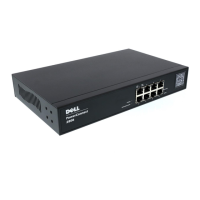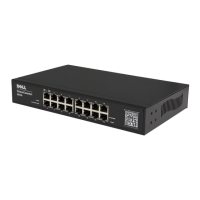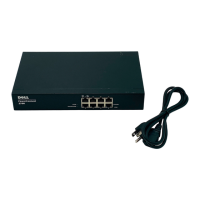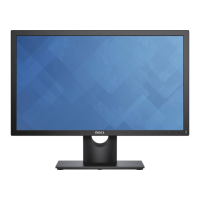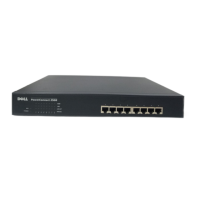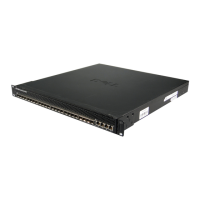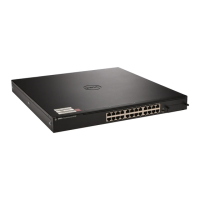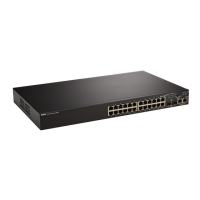Do you have a question about the Dell PowerConnect 2848 and is the answer not in the manual?
Describes the hardware configurations of the PowerConnect 28xx switches managed by Dell's OpenManage Switch Administrator.
Details general features, management modes, and supported protocols and technologies of the PowerConnect switches.
Explains the front and back panel port descriptions and configurations for PowerConnect 28xx switches.
Details the indications for Power LED, Managed Mode LED, Fan LED, and Port LEDs on the switch front panels.
Provides information on switch physical interfaces, cable requirements, port connections, and RJ-45/SFP pinouts.
Outlines essential safety precautions and guidelines before installing the PowerConnect device.
Specifies the necessary power, clearance, cabling, and ambient environmental requirements for device installation.
Provides instructions for unpacking the device, including checking package contents and the unpacking procedure.
Details the three device mounting options: rack, flat surface, and wall installation, with specific instructions.
Guides on connecting the device to the network, a terminal, and a power supply for configuration.
Describes the Managed, Unmanaged, and Secure modes of operation for the device.
Explains the procedures for switching between Managed, Secure, and Unmanaged operating modes.
Guides users through the initial device configuration process using the setup wizard.
Provides steps for configuring the device via its web management interface.
Details procedures accessible from the startup menu, including software download and password recovery.
Introduces the components and views of the Dell OpenManage Switch Administrator interface.
Provides instructions on how to launch and access the Dell PowerConnect OpenManage Switch Administrator.
Explains the different access levels (Management, Monitor) assigned to users upon login.
Details how to define general device parameters like system name, location, and MAC address.
Explains the procedure for resetting the device remotely using the Reset page.
Describes how to enable Secure Mode to prevent configuration changes and enhance security.
Guides on assigning IP addresses, subnet masks, and default gateways to the device.
Provides procedures for performing virtual cable tests on copper cables and optical transceivers.
Covers security settings including local user databases and RADIUS server configuration.
Explains network security features like Port Based Authentication and Access Control Lists.
Details port parameters, aggregation, Green Ethernet, Storm Control, and Port Mirroring.
Covers STP global and port settings, including Rapid Spanning Tree and STP LAGs.
Explains VLAN configuration, including members, port settings, and LAG settings.
Provides information on device utilization and errors using RMON statistics.
Describes how to access pages for displaying statistics in chart format.
Details information on the system's CPU utilization and percentage of resources consumed.
Sets Quality of Service (QoS) global parameters, including CoS and Trust modes.
Configures QoS settings per interface, including Trust mode and default CoS values.
Configures the scheduling method for maintaining queues, including Strict Priority and WRR.
Defines the classification of CoS settings to traffic queues.
Provides fields for defining output queue assignments based on specific DSCP fields.
Explains how to access the device via console port or Telnet connection using the Command Line Interface.
Provides steps for establishing and using a console connection to the device.
Details how to establish and use a Telnet session for remote device management.
Describes the different command modes in the CLI: User EXEC, Privileged EXEC, and Global Configuration.
Lists and explains common CLI commands for file transfer, debugging, and configuration.
Describes the hardware configurations of the PowerConnect 28xx switches managed by Dell's OpenManage Switch Administrator.
Details general features, management modes, and supported protocols and technologies of the PowerConnect switches.
Explains the front and back panel port descriptions and configurations for PowerConnect 28xx switches.
Details the indications for Power LED, Managed Mode LED, Fan LED, and Port LEDs on the switch front panels.
Provides information on switch physical interfaces, cable requirements, port connections, and RJ-45/SFP pinouts.
Outlines essential safety precautions and guidelines before installing the PowerConnect device.
Specifies the necessary power, clearance, cabling, and ambient environmental requirements for device installation.
Provides instructions for unpacking the device, including checking package contents and the unpacking procedure.
Details the three device mounting options: rack, flat surface, and wall installation, with specific instructions.
Guides on connecting the device to the network, a terminal, and a power supply for configuration.
Describes the Managed, Unmanaged, and Secure modes of operation for the device.
Explains the procedures for switching between Managed, Secure, and Unmanaged operating modes.
Guides users through the initial device configuration process using the setup wizard.
Provides steps for configuring the device via its web management interface.
Details procedures accessible from the startup menu, including software download and password recovery.
Introduces the components and views of the Dell OpenManage Switch Administrator interface.
Provides instructions on how to launch and access the Dell PowerConnect OpenManage Switch Administrator.
Explains the different access levels (Management, Monitor) assigned to users upon login.
Details how to define general device parameters like system name, location, and MAC address.
Explains the procedure for resetting the device remotely using the Reset page.
Describes how to enable Secure Mode to prevent configuration changes and enhance security.
Guides on assigning IP addresses, subnet masks, and default gateways to the device.
Provides procedures for performing virtual cable tests on copper cables and optical transceivers.
Covers security settings including local user databases and RADIUS server configuration.
Explains network security features like Port Based Authentication and Access Control Lists.
Details port parameters, aggregation, Green Ethernet, Storm Control, and Port Mirroring.
Covers STP global and port settings, including Rapid Spanning Tree and STP LAGs.
Explains VLAN configuration, including members, port settings, and LAG settings.
Provides information on device utilization and errors using RMON statistics.
Describes how to access pages for displaying statistics in chart format.
Details information on the system's CPU utilization and percentage of resources consumed.
Sets Quality of Service (QoS) global parameters, including CoS and Trust modes.
Configures QoS settings per interface, including Trust mode and default CoS values.
Configures the scheduling method for maintaining queues, including Strict Priority and WRR.
Defines the classification of CoS settings to traffic queues.
Provides fields for defining output queue assignments based on specific DSCP fields.
Explains how to access the device via console port or Telnet connection using the Command Line Interface.
Provides steps for establishing and using a console connection to the device.
Details how to establish and use a Telnet session for remote device management.
Describes the different command modes in the CLI: User EXEC, Privileged EXEC, and Global Configuration.
Lists and explains common CLI commands for file transfer, debugging, and configuration.
| Ports | 48 x 10/100/1000BASE-T |
|---|---|
| Uplink Ports | 4 x SFP |
| Switching Capacity | 96 Gbps |
| Forwarding Rate | 71.4 Mpps |
| VLAN Support | Yes |
| Rack Mountable | Yes, 1U |
| Jumbo Frame Support | Yes |
| Management | CLI |
| Power Consumption | 45W |
| Weight | 3.4 kg (7.5 lbs) |
| Operating Temperature | 0°C to 45°C (32°F to 113°F) |
| Storage Temperature | -20°C to 70°C (-4°F to 158°F) |
| Relative Humidity | 10% to 90% (non-condensing) |
| Standards Compliance | IEEE 802.3, IEEE 802.3u, IEEE 802.3ab, IEEE 802.3z |
| Dimensions | 440 x 250 x 44 mm (17.3 x 9.8 x 1.7 in) |
